Mt. Fuji and Environs
Shimoda, Izu Peninsula, SHIZUOKA
4 Days 3 Night
Shimoda, Izu Peninsula, SHIZUOKA
4 Days 3 Night
- Day 1
- Tokyo – Mt. Fuji – Shimoda
Travel from Tokyo to Mt. Fuji by private car.
Continue on your way by driving the scenic Fuji Subaru Line up to Mt. Fuji 5th station. This is a great place for sightseeing, with incredible views of the surroundings. People who climb the mountain often start their trek here. This 5th station is also known as Yoshidaguchi 5th station and is the most popular station of Mt. Fuji because of its easy access.

In summer, climbing up to the top of Mt. Fuji is very popular for both Japanese and foreigners. Especially popular is to climb through the night to see the sunrise from the summit. Mt. Fuji is considered one of the “Three Holy Mountains” along with Mt. Tate and Mt. Haku, and is a symbol of Japan. It is registered as a UNESCO World Heritage site along with its environs.
At the mountain’s base is the beautiful Fujiyoshida Sengen Shrine, dedicated to Princess Konohanasakuya, the Shinto goddess of Mt. Fuji. For centuries, pilgrims have passed through the shrine and offered a prayer to the sacred mountain before continuing their trek. Behind the shrine is the Yoshida trailhead, which leads up the mountain to the summit, although most climbers start at the 5th station, which shortens the climb by about five hours.
*Advance booking is required with guide.
If you are keen to learn more about Mt. Fuji, you may join one of these three activities to discover the famous mountain.
Option 1 – Explore Mt. Fuji Lava Caves If you want a truly special and unique experience in Japan, check out the Mt. Fuji Lava Caves. In addition to the caves, our guides will introduce you to the wonders of the famous Aokigahara forest in the Mt. Fuji foothills, with its strange, mysterious world of eerie silence, darkness and tranquility.
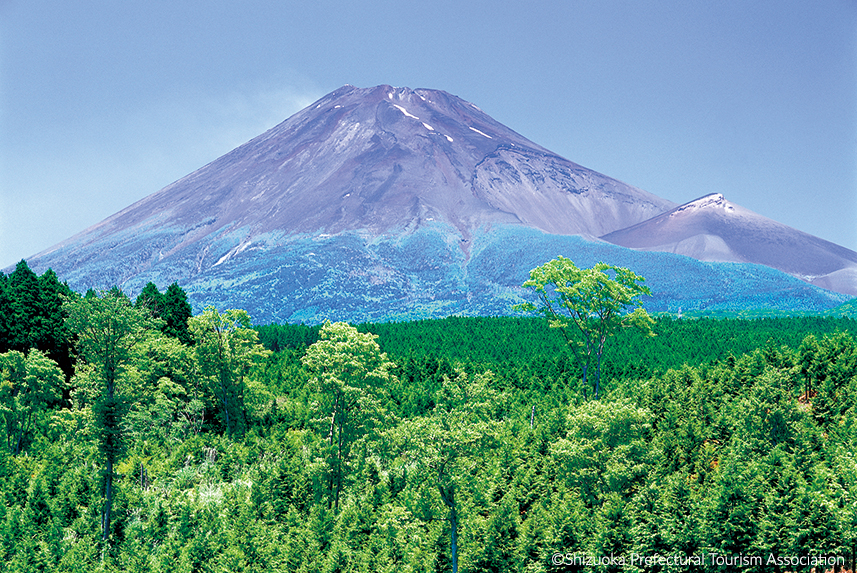
Option 2 – Nature walk in the forest near Mt. Fuji The foothills of Mt. Fuji are a great place for a nature hike to learn about the fascinating birds and plants of this area. This tour is perfect for anyone interested in enjoying the natural world surrounding Mt. Fuji with a guide who is well versed in the local flora, fauna and geology. This tour can take place in various locations, depending on which is the most convenient.
*Available in summer only
Option 3 – Trekking in Houei Crater
Though it hasn’t erupted in hundreds of years, Mt. Fuji is still an active volcano. Our Houei Crater trekking tour starts from the 5th station, from where we will hike to the 6th station and beyond to admire the magnificent views from the Houei Crater, as well as discover the tough, resilient plant life at the tree line and the craters formed in previous eruptions.
*Available in summer only
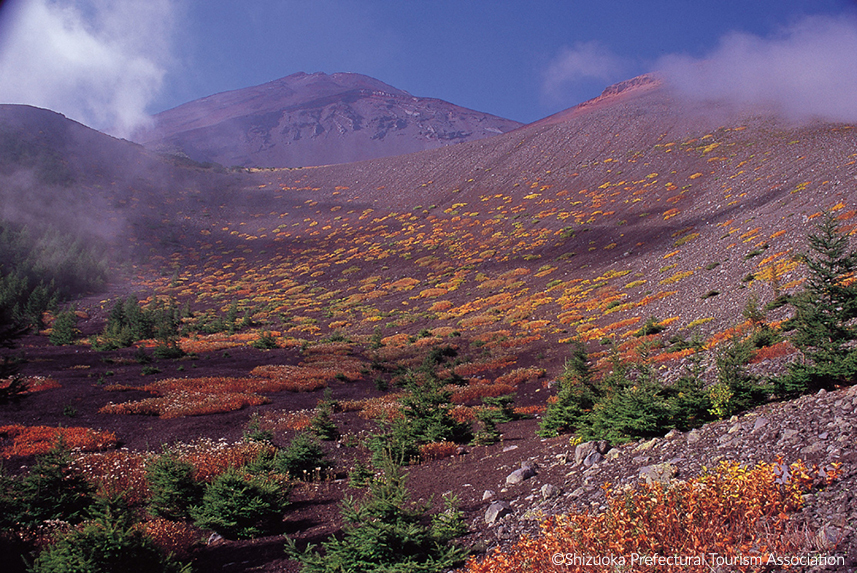
In the afternoon you will leave for the Izu Peninsula, a place famous for its hot springs and beautiful views of Mt. Fuji.
Check in at the ryokan in Shimoda, Izu Peninsula.
Seiryuso
Tucked away in Rendaiji, an elegant corner of Shizuoka, the beautiful Seiryuso is Japanese ryokan at its finest. With its elegant architecture, fine gardens, delicious food and unsurpassed service, Seiryuso is the very definition of a high-end ryokan. It is the perfect place to experience the timeless attraction of omotenashi, or traditional Japanese hospitality.
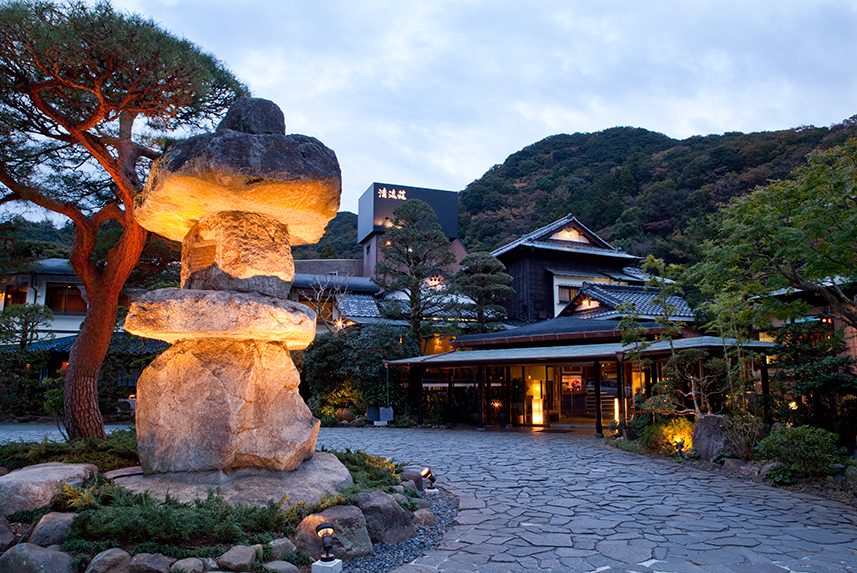
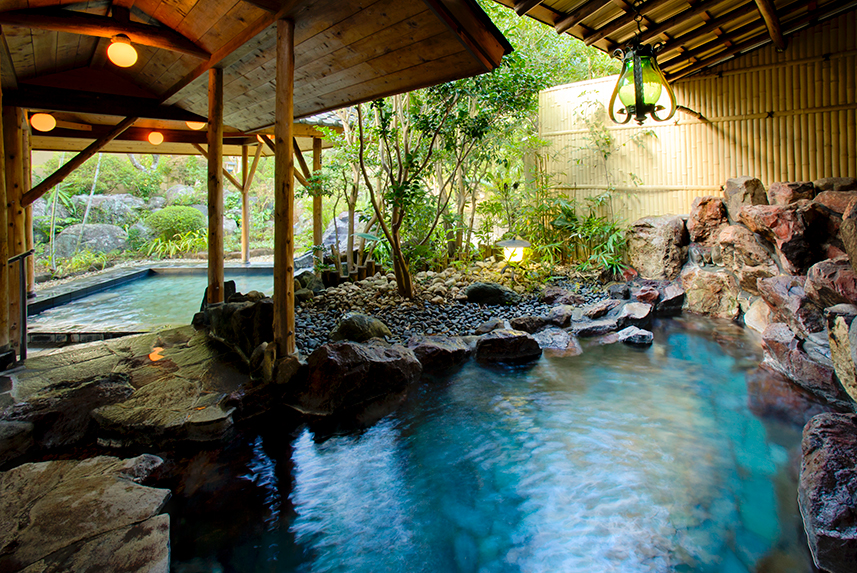
Continue on your way by driving the scenic Fuji Subaru Line up to Mt. Fuji 5th station. This is a great place for sightseeing, with incredible views of the surroundings. People who climb the mountain often start their trek here. This 5th station is also known as Yoshidaguchi 5th station and is the most popular station of Mt. Fuji because of its easy access.

In summer, climbing up to the top of Mt. Fuji is very popular for both Japanese and foreigners. Especially popular is to climb through the night to see the sunrise from the summit. Mt. Fuji is considered one of the “Three Holy Mountains” along with Mt. Tate and Mt. Haku, and is a symbol of Japan. It is registered as a UNESCO World Heritage site along with its environs.
At the mountain’s base is the beautiful Fujiyoshida Sengen Shrine, dedicated to Princess Konohanasakuya, the Shinto goddess of Mt. Fuji. For centuries, pilgrims have passed through the shrine and offered a prayer to the sacred mountain before continuing their trek. Behind the shrine is the Yoshida trailhead, which leads up the mountain to the summit, although most climbers start at the 5th station, which shortens the climb by about five hours.
*Advance booking is required with guide.
If you are keen to learn more about Mt. Fuji, you may join one of these three activities to discover the famous mountain.
Option 1 – Explore Mt. Fuji Lava Caves If you want a truly special and unique experience in Japan, check out the Mt. Fuji Lava Caves. In addition to the caves, our guides will introduce you to the wonders of the famous Aokigahara forest in the Mt. Fuji foothills, with its strange, mysterious world of eerie silence, darkness and tranquility.

Option 2 – Nature walk in the forest near Mt. Fuji The foothills of Mt. Fuji are a great place for a nature hike to learn about the fascinating birds and plants of this area. This tour is perfect for anyone interested in enjoying the natural world surrounding Mt. Fuji with a guide who is well versed in the local flora, fauna and geology. This tour can take place in various locations, depending on which is the most convenient.
*Available in summer only
Option 3 – Trekking in Houei Crater
Though it hasn’t erupted in hundreds of years, Mt. Fuji is still an active volcano. Our Houei Crater trekking tour starts from the 5th station, from where we will hike to the 6th station and beyond to admire the magnificent views from the Houei Crater, as well as discover the tough, resilient plant life at the tree line and the craters formed in previous eruptions.
*Available in summer only

In the afternoon you will leave for the Izu Peninsula, a place famous for its hot springs and beautiful views of Mt. Fuji.
Check in at the ryokan in Shimoda, Izu Peninsula.
Seiryuso
Tucked away in Rendaiji, an elegant corner of Shizuoka, the beautiful Seiryuso is Japanese ryokan at its finest. With its elegant architecture, fine gardens, delicious food and unsurpassed service, Seiryuso is the very definition of a high-end ryokan. It is the perfect place to experience the timeless attraction of omotenashi, or traditional Japanese hospitality.


- Day 2
- Shimoda
Around Shimoda station there are some attractions. A 10 minute taxi ride takes you to Shimoda station.
Shimoda Park
Shimoda Park is an attractive wooded park on a hill. There are about 150,000 hydrangea plants in the park, and in season about 3 million flowers bloom. The Hydrangea Festival is held in June every year. From the far side of the park you can get a preview of the wildly rugged coastline of the southern tip of the Izu Peninsula. In Shimoda Park are the ruins of a castle.
Perry Road and Ryosen-ji (temple)
In 1853, Commodore Matthew C. Perry arrived at Japan with his fleet of Black Ships, to request the opening of Japanese ports to ships of the United States. The signing ceremony for the Japan-U.S. Peace Treaty was held at Ryosenji temple. Several years later, the first American consulate was established. The walk itself is just a short fifteen minutes from end to end, but it's packed with shops selling traditional crafts, restaurants, cafes and pubs and is crisscrossed by numerous picturesque bridges.
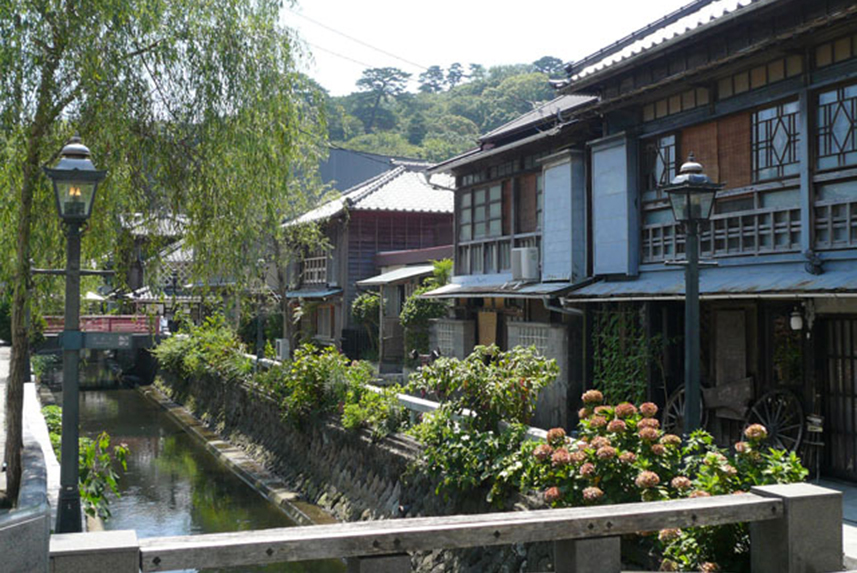
Ropeway (Mount Nesugata Nature Park)
A short walk from Shimoda’s train station, the Shimoda Ropeway (also known as the Nesugatayama Ropeway) is the best place to go to capture the true panoramic beauty of the town and harbor. The summit also features a beautiful nature park immaculately manicured with seasonal flowers, a rotunda-style Buddhist pavilion that is a well-known power spot, and several 19th century cannons with their sights still aimed at the bay where Perry’s ships once anchored. It’s a wonderful way to spend a day in Shimoda, and the brisk seaside breezes at the top help cool you down after your stroll through town.
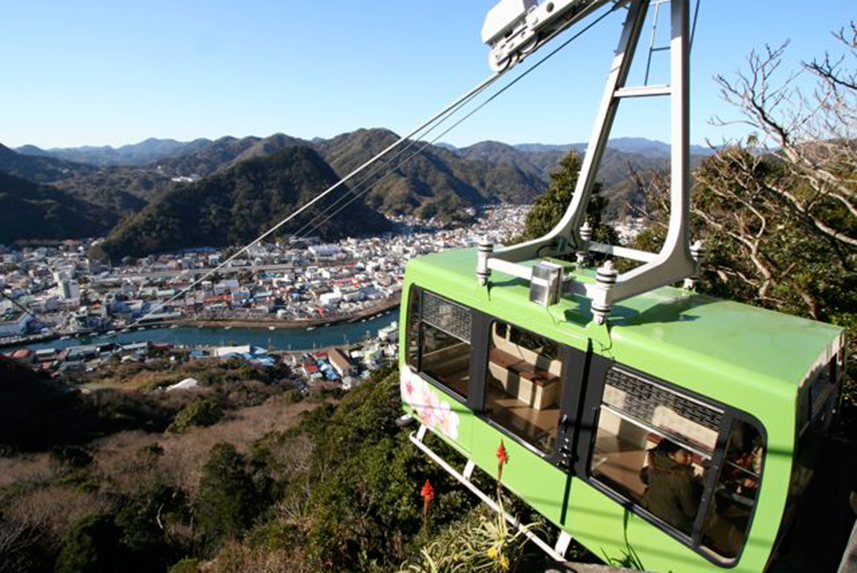
Shimoda harbor Black Ship tour
Cruise around Shimoda harbor in a life-size replica of the Susquehanna, the "black ship" that brought Commodore Perry here in 1854. On the cruise you can enjoy the view of the city and mountains nearby, the same scenery that greeted Perry and his crew.
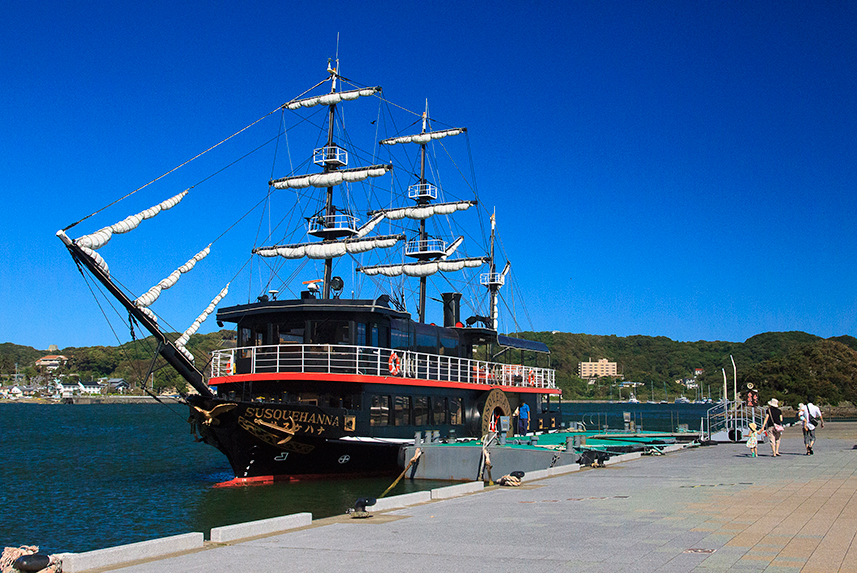
Return to the ryokan.
Shimoda Park
Shimoda Park is an attractive wooded park on a hill. There are about 150,000 hydrangea plants in the park, and in season about 3 million flowers bloom. The Hydrangea Festival is held in June every year. From the far side of the park you can get a preview of the wildly rugged coastline of the southern tip of the Izu Peninsula. In Shimoda Park are the ruins of a castle.
Perry Road and Ryosen-ji (temple)
In 1853, Commodore Matthew C. Perry arrived at Japan with his fleet of Black Ships, to request the opening of Japanese ports to ships of the United States. The signing ceremony for the Japan-U.S. Peace Treaty was held at Ryosenji temple. Several years later, the first American consulate was established. The walk itself is just a short fifteen minutes from end to end, but it's packed with shops selling traditional crafts, restaurants, cafes and pubs and is crisscrossed by numerous picturesque bridges.

Ropeway (Mount Nesugata Nature Park)
A short walk from Shimoda’s train station, the Shimoda Ropeway (also known as the Nesugatayama Ropeway) is the best place to go to capture the true panoramic beauty of the town and harbor. The summit also features a beautiful nature park immaculately manicured with seasonal flowers, a rotunda-style Buddhist pavilion that is a well-known power spot, and several 19th century cannons with their sights still aimed at the bay where Perry’s ships once anchored. It’s a wonderful way to spend a day in Shimoda, and the brisk seaside breezes at the top help cool you down after your stroll through town.

Shimoda harbor Black Ship tour
Cruise around Shimoda harbor in a life-size replica of the Susquehanna, the "black ship" that brought Commodore Perry here in 1854. On the cruise you can enjoy the view of the city and mountains nearby, the same scenery that greeted Perry and his crew.

Return to the ryokan.
- Day 3
- Day trip
Today, you may relax at the ryokan. Otherwise you may visit some sightseeing spots by private car.
In spring travel to Kawazu, which is famous for Kawazu-zakura early-blooming cherry blossom trees. Usually these sakura bloom from late February to early March, and the flowers open unusually slowly, so the season lasts longer than usual. During sakura season the town holds a festival every year, with dozens of stalls offering food, souvenirs, and local products. There are also famous hot-spring baths in the town, which is the setting for “Izu Dancer,” the famous novel by Kawabata Yasunari.
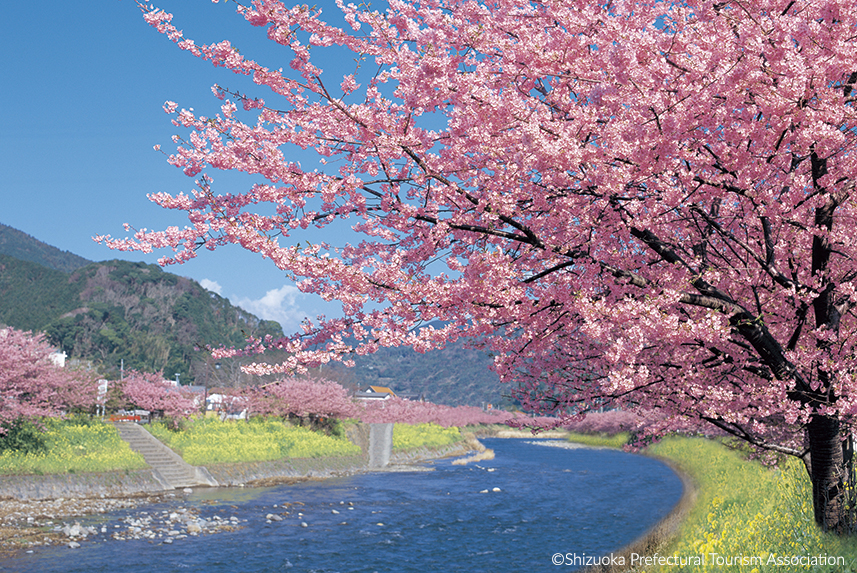
Visit wasabi fields in Amagi.
Wasabi, the definitive horseradish that gives the zing to sushi, needs clear, clean water and a particular set of climatic circumstances to grow well. It’s not a very common sight, and very few people have seen natural wasabi, even in Japan. Thanks to its abundant mountain streams, the Amagi area has many wasabi fields and is famous for the quality of its wasabi, as well as the beauty of its landscape.
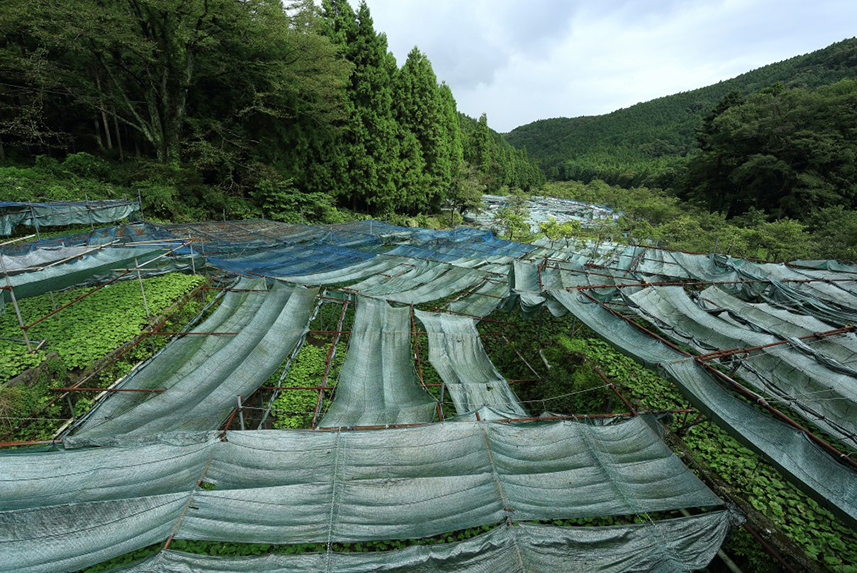
At Namesawa Gorge, enjoy a landscape of the beautiful valley.
The expanse of level rock that makes up the floor of this beautiful gorge is actually a field of lava that flowed through the valley eons ago, filling it up and creating the beautiful topography we see today. The gorge is a lovely location, with streams cascading among the hard laval rocks, as well as lush nature. Namesawa Gorge is famous for its red leaves in the fall.
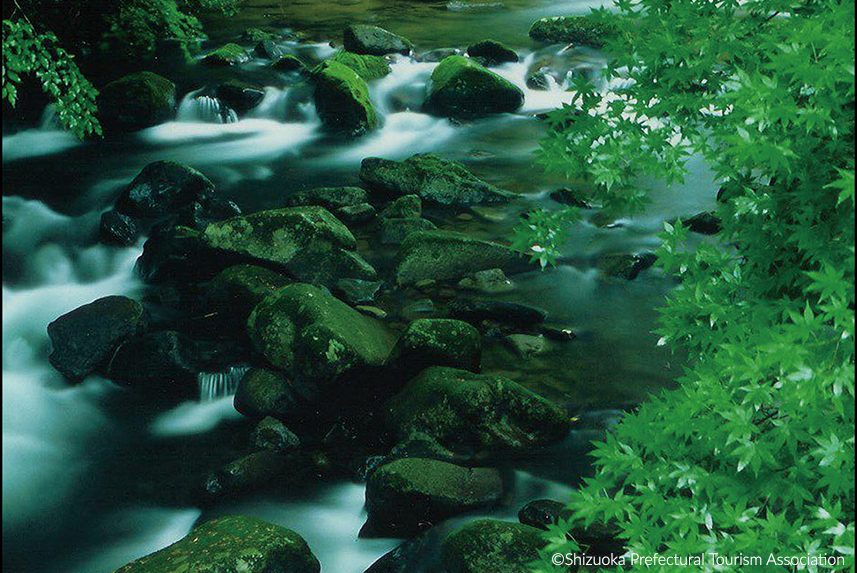
Otherwise, you may take a west coast route to enjoy the rich nature and beautiful scenery of the Nishi Izu area.
This is a region with a unique and beautiful landscape, as well as an intricate coastline featuring towering cliffs, uniquely shaped rocks and small islands. Up the coast is the Golden Cape, named for its golden color at sunset. The cape is famous for its rugged scenery, and the powerful white-capped waves that pound the base of the towering cliffs. This is a popular tourist spot.
Dogashima is a popular scenic spot of Nishi Izu. In this area you can find hundreds of caves, as well as cliffs formed by the lava flows of past volcanic eruptions and you can also enjoy the beautiful clear ocean water. Sanshiro-jima is one of the most popular spots in Dogashima area. There is a rocky path there that appears at low tide so you can walk out to the island.
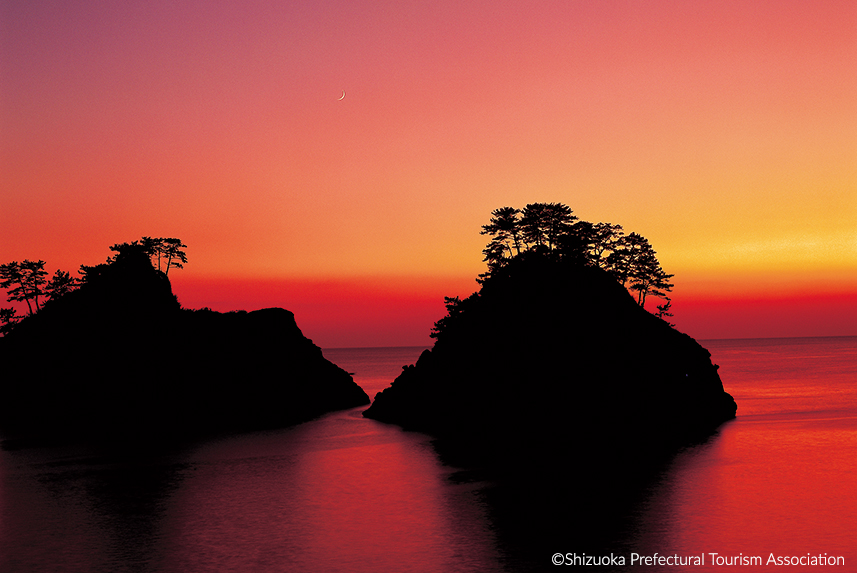
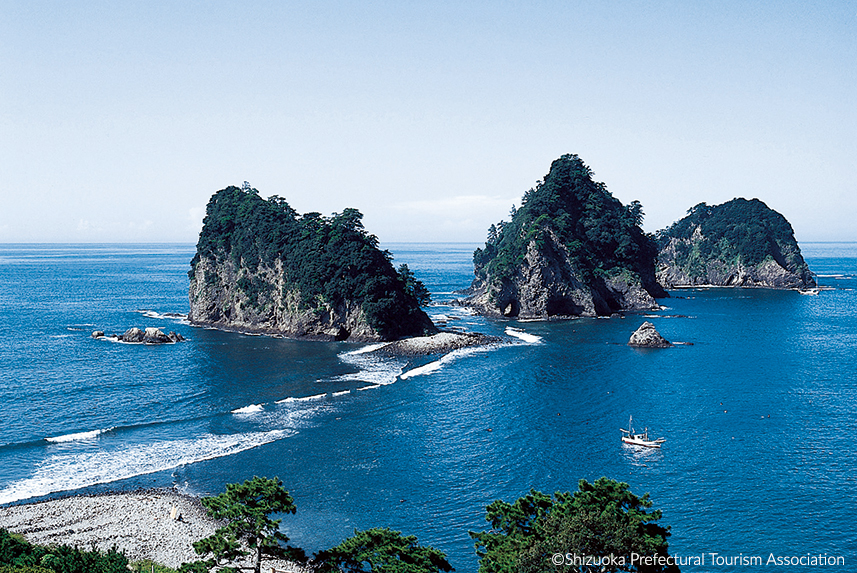
You could also join a sightseeing boat for a cave excursion. Visiting the caves by boat is a popular activity in Nishi Izu and is the best way to see its “rias” coastline. The caves are spectacular, with mysterious light filtering down through the cave ceiling.
Return to the ryokan.
In spring travel to Kawazu, which is famous for Kawazu-zakura early-blooming cherry blossom trees. Usually these sakura bloom from late February to early March, and the flowers open unusually slowly, so the season lasts longer than usual. During sakura season the town holds a festival every year, with dozens of stalls offering food, souvenirs, and local products. There are also famous hot-spring baths in the town, which is the setting for “Izu Dancer,” the famous novel by Kawabata Yasunari.

Visit wasabi fields in Amagi.
Wasabi, the definitive horseradish that gives the zing to sushi, needs clear, clean water and a particular set of climatic circumstances to grow well. It’s not a very common sight, and very few people have seen natural wasabi, even in Japan. Thanks to its abundant mountain streams, the Amagi area has many wasabi fields and is famous for the quality of its wasabi, as well as the beauty of its landscape.

At Namesawa Gorge, enjoy a landscape of the beautiful valley.
The expanse of level rock that makes up the floor of this beautiful gorge is actually a field of lava that flowed through the valley eons ago, filling it up and creating the beautiful topography we see today. The gorge is a lovely location, with streams cascading among the hard laval rocks, as well as lush nature. Namesawa Gorge is famous for its red leaves in the fall.

Otherwise, you may take a west coast route to enjoy the rich nature and beautiful scenery of the Nishi Izu area.
This is a region with a unique and beautiful landscape, as well as an intricate coastline featuring towering cliffs, uniquely shaped rocks and small islands. Up the coast is the Golden Cape, named for its golden color at sunset. The cape is famous for its rugged scenery, and the powerful white-capped waves that pound the base of the towering cliffs. This is a popular tourist spot.
Dogashima is a popular scenic spot of Nishi Izu. In this area you can find hundreds of caves, as well as cliffs formed by the lava flows of past volcanic eruptions and you can also enjoy the beautiful clear ocean water. Sanshiro-jima is one of the most popular spots in Dogashima area. There is a rocky path there that appears at low tide so you can walk out to the island.


You could also join a sightseeing boat for a cave excursion. Visiting the caves by boat is a popular activity in Nishi Izu and is the best way to see its “rias” coastline. The caves are spectacular, with mysterious light filtering down through the cave ceiling.
Return to the ryokan.
- Day 4
- Departure
Check out from the ryokan and travel back to Tokyo from Shimoda station by limited train Super View Odoriko, a journey of 2 and a half hours.
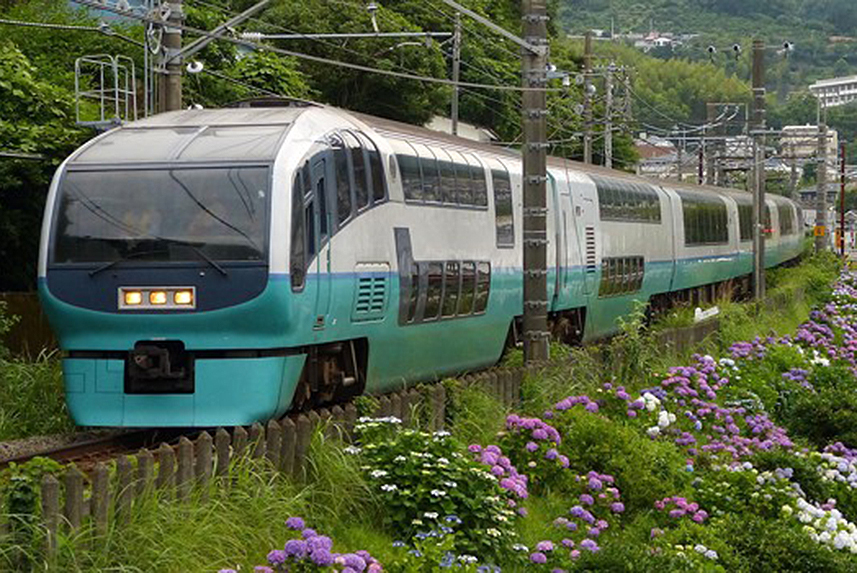
You may also travel to Kyoto by Shinkansen bullet train from Mishima station, which takes 2 hours.

You may also travel to Kyoto by Shinkansen bullet train from Mishima station, which takes 2 hours.







